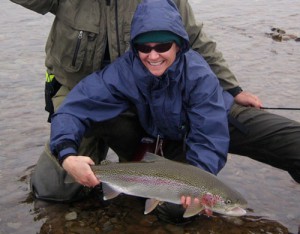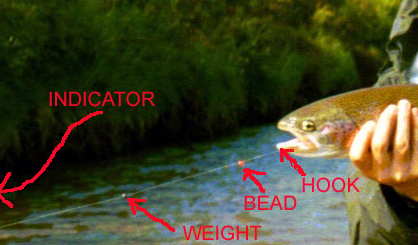Alaska Egg Fishing

Egg fishing is almost as exciting to me as dry fly fishing. Before you say that I am nuts and you’ll never go on a trip with me again, hear me out! I have fished in Alaska for years å I have become a fairly accomplished egg drifter. The part that makes it exciting is that you have more than the dry fly to worry about. You have an indicator on top and a fly on the bottom and you need to keep track of both. Add to the mix sight fishing in clear water where you can see the fish, the egg and the indicator and it starts to be clear this is fun! During those encounters I actually watch the fish and my indicator at the same time. It’s sort of like an experienced videographer from the music video production that watches through the cameras eyepiece and out of their free eye to see the rest of the world. With a dry fly you have to get the drift right just like you do with a nymph or egg but the strike is usually obvious, you watch the fly and the fish eats it and you’re on, Don’t get me wrong, that’s still the best but when you sight fish with eggs you add a third dimension. Detecting the take is a combination of watching the indicator and the behavior of the fish at the same time.

Sometimes the take is obvious: the fish moves a foot to the fly and the indicator sucks down with a vengeance. Other times the indicator doesn’t move but the fish ate something when your fly should have been there, still other times the action of the fish can be followed by the tick of the indicator giving you just enough warning to set the hook just before they spit it out. The intense concentration needed is what makes it so exciting. The fact that these are the 5-15 pound trout of the Moraine doesn’t hurt either! So the next time you are nymphing or egging with an indicator get three dimensional and start thinking about what is going on below the surface. In most situations you won’t be able to see the fish take the fly but there are a few things you can do to increase your odds in detecting the take. Here is the golden rule: the indicator should be downstream of the fly and the indicator should be fairly tight to the weight and fly. It seems obvious, but in order to see the indicator move the fly must be in the fishes mouth and then the leader must come tight to the indicator as it floats downstream before the fish drops the fly. The first thing you can do to help is to watch your cast and notice where your fly lands in relation to your indicator. Most casts will be 3/4 up and across the current. You want the fly and the weight to land upstream of the indicator. This way if a fish takes it quickly you will notice the take right away as the fly is already tight to the indicator. If the fly landed downstream of the indicator the fly will start to sink to the bottom . If the fish takes the fly at this point then the indicator will float uninterrupted without any sign of a strike until it comes tight downstream of fly. The fish has had plenty of time to eat the fly and spit it out. Eventually the indicator will float downstream of the fly and you will be able to detect strikes again. So make sure the fly lands up stream of the indicator or you will miss a lot of takes. Don’t be afraid to give the fly a little jig once in a while to make sure the system is tight.

If you always keep in mind the golden rule that the indicator should be downstream of the fly and be fairly tight to the weight and fly then you can start to apply to different situations. If you are throwing the fly into fast water while the indicator is sitting in slow water, you’ll rarely detect the strike. The fly simply lifts off the bottom and swings downstream below the indicator. Sure, aggressive rainbows like we have in Alaska may still eat the egg or nymph even when it is not presented well, but there is no sense relying on the fish to be completely stupid. The next thing I have learned while fishing egg patterns in Alaska is to get long drifts. The first few seconds after the cast you are just waiting for the fly to reach the bottom. If it ain’t at the fish’s eye level he probably won’t eat it. On an standard up and across cast in fast current, the fly may reach the bottom when it has drifted just about in front of you. Now you are fishing. If you pick it up here to recast you have wasted a cast. Lift the line off the water without bumping the indicator and throw a nice upstream mend and continue to feed a little extra slack in the line. If your fly line looks tight to the indicator you are probably pulling the fly off the bottom. I like to see at least a little curl of the fly line near the indicator to make sure it is a dead drift. Once you get th e hang of feeding slack into the drift without yanking the indicator you can get some very long drifts. As some of you know we can get away with large yarn indicators in Alaska so I can see them 75 feet downstream. These long drifts can be deadly as your fly is at the fishes level for a lot longer period of time. This technique then creates a new problem. Setting the hook with more slack than you are used to.
A simple “water strike” will work by setting the hook sweeping the rod low and to the side. The water tension along the line will create enough movement in the fly to set the hook. Practice a few times by throwing too much slack and see what you can do to set the hook and make the indicator jump a bit. If there is not much slack in the line, a standard lift strike will do the trick. Don’t be afraid to set the hook. If it might be a strike set the hook. I fish with some people that say “Oh, that was the bottom” Maybe, sometimes you can feel the difference but eight times out of ten that tick will look the same whether it is bottom or a fish. Set the hook!! You’ll see me rip the line out like a fool sometimes just cause I think, I sort of, maybe saw the indicator move. If you don’t overreact once in awhile ending up with the line and fly draped all over you then you probably are missing takes. Golden rule #2: When in doubt, set the hook. Maybe this will help take some of the mystery out of Alaska style egg fishing. It is an easy technique to master and almost as rewarding as dry fly fishing.
